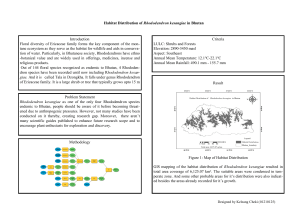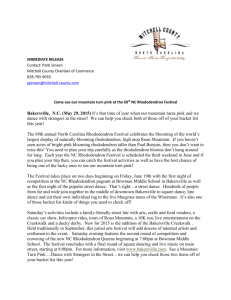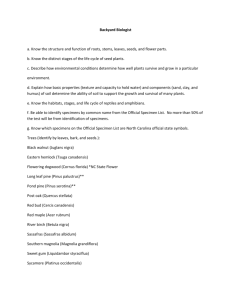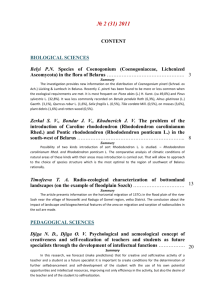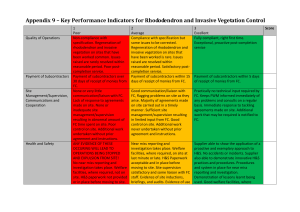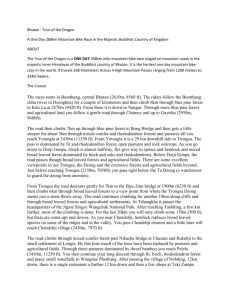Wild Rhododendrons of Bhutan
advertisement
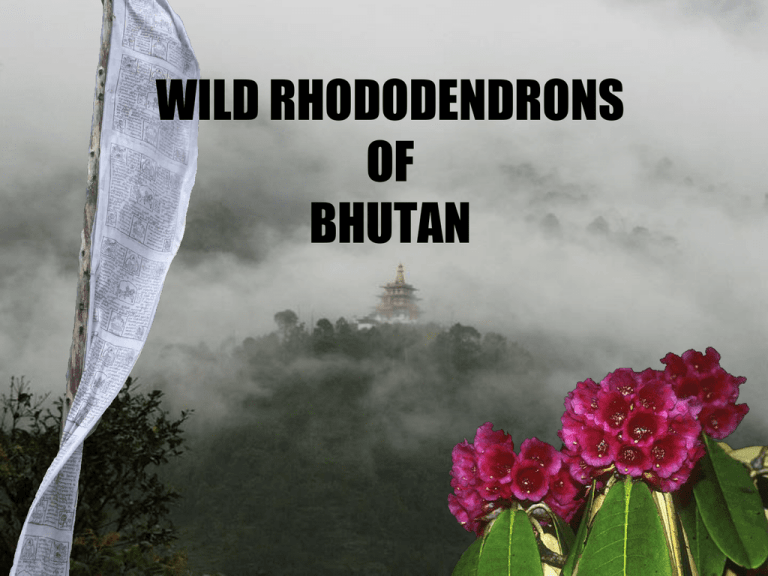
WILD RHODODENDRONS OF BHUTAN Location Latitudes..26040’ and 28015’N Longitudes..88045’ and 92010’East. Country Profile Capital City: Thimphu Total Land Cover: 38,36459 sq. km. Population: 0.7million Forest Cover: 65.5% Cultivated area: 8% People Major Ethnic Groups •Ngalongs •Sharchops •Lhotshams Religion : Buddhism Rhododendrons of Bhutan In Bhutan many species of rhododendrons are found to exist in assemblages that vary according to changes in altitude, aspect and longitudinal east west axis. 46 species of Rhododendrons are described in Flora of Bhutan Vol. II Part 1. Out of these 46 species, four are endemic to Bhutan. R. Kesangiae var. album Zhidey 1. R.kesangiae Long & Rushforth 2. R.pogonophyllum Cowan & Davidian 3. R.bhutanense Long & Bowes Lyon 4. R.flinckii Davidian. R. bhutanense R. kesangiae *R. kesangiae, named in honour of HRH The Queen Mother of Bhutan, Ashi Kesang Choden Wangchuck ** R. kesangiae var. album Zhidey, symbolizes the 50th Anniversary of the United Nations (1945-1995). Features & Characteristics Family: Ericaceae Rhododendrons vary in shape, size and form ranging from low creeping shrub of 10 cm tall to big trees of 20 m with dbh of 70cm. Several species are tall trees; some form the understorey of conifer/broad-leaved forests, and some form dominant vegetation patches in alpine meadows above tree line while others tend to be epiphytic. Rhododendrons hybridize readily in the wild, where several species occur in groups. Rhododendron Ecosystem diversity Subtropical Forest … 150m – 1000m+ (Southern belt of the country) Warm Broad-Leaved Forest..Alt: 1000-2000 m Cool Broad-leaved & Conifer Forest (Temperate) Alpine Zone Subtropical Zone: Alt 150 – 1000+ m The only species found in this zone is Rhododendron arboreum from altitude 900 m to 3300m. Known as Lali-gurans in lhotsomkha, it signifies the season of spring in Bhutan. Warm broad-leaved Forest … 1000 – 2000+ R. virgatum R. griffithianum Rhododendron species found: 1. R. arboreum, 2. R.griffithianum, 3. R. grande, 4. R.papillatum, 5. R.maddenii, 6. R.dalhousiae, 7. R.dalhousiae var. rhabdotum, 8. R. lindleyi, 9. R. virgatum, 10. R.edgeworthii R. papillatum R. grande Cool broad-leaved Forest and Conifer Forest: Alt 1800m-4200m (Temperate Zone) Most favorable habitat for Rhododendron. The assemblages of species vary from homogenous to heterogeneous. Rhododendron kesangiae Long & Rushforth and R. hodgsonii Hook.f. prefer moist habitats with misty weather and are confined to particular altitude. These species indicate wet places but Rhododendron arboreum Smith is fairly widespread and indicate drier regions. Rhododendron kesangiae var. album is common toward the east while R.argipeplum Balfour f. & Cooper replaces R. barbatum G.Don in the east. Rhododendron species found in this zone: 1. R. arboreum, 2. R.griffithianum, 3. R. grande, 4. R. kesangiae, 5. R.falconeri, 6. R. hodgsonii, 7. R. campylocarpum, 8. R.kindrickii, 9. R.niveum, 10. R.wightii, 11. R. lanatum, 12. R. tsariense, 13. R.papilatum, 14. R.maddenii, 15. R.dalhousiae, 16. R.dalhousiae var. rhabdotum, 17. R. lindleyi, 18. R. virgatum, 19. R.edgeworthii, 20. R.wallichii, 21. R. barbatum, 22. R. argipeplum, 23. R.succothii, 24. R.neriiflorum, 25. R.fulgens, 26. R. pendulum, 27. R.ciliatum, 28. R. triflorum, 29. R. vacciniodes, 30. R. cinnabarinum, 31. R. keysii, 32. R. camelliiflorum, 33. R. glaucophyllum, 34. R.baileyi Some species are understorey of Cool broad-leaved forest and some are understorey of conifer forest. R.falconeri, R. kesangiae and R grande colonize and form a pure thick forest of single species. R. falconeri R. hodgosonii R. pendulum R. ciliatum R. campylocarpum R. keysii R. dalhousiae rhabdotum var. R. wallichii R. cinnabarinum R. baileyi R. arboreum R. lindleyi R. maddenii R. tsariense R. argipeplum R. barbatum R. succothii R. triflorum R. neriiflorum R. wightii R. glaucophyllum Alpine Zone: Alt 3000 – 5200 m Rhododendrons found in this zone: 1. R. bhutanense, 2. R.lanatum, 3. R. flinckii, 4. R. aeruginosum, 5. R. thomsonii, 6. R.nivale, 7. R.pumilum, 8. R.cinnabarinum 9. R.setosum, 10. R.lepidotum, 11. R.anthopogon, 12. R.pogonophyllum, 13. R. fragariiflorum, 14. R. campanulatum These species are found in open meadows and marshy areas and are colonized. Some places are very difficult to penetrate. These places also provide shelter to Musk deer, Tragopans and Pheasants. *Dwarf rhododendrons are quite common.at the altitude range of 3500m to 4500m R. fragariflorum R. anthopogon R. thomsonii R. lepidotum R. aeroginosum R. setosum Species Distribution Graph by Zones No. of Species 35 30 25 20 15 10 5 0 S W T A Different Zones S - Subtropical; W - Warm Broad-leaved; T- Temperate; A- Alpine Local Uses of Rhododendrons Several species of rhododendrons are of ethno-botanical value. Rhododendron anthopogon D.Don, R. nivale Hook.f., R. fragariiflorum Kingdon Ward, R. setosum D.Don and R.lepidotum G.Don are mixed with Juniperous species to make incense. This highly valued incense is widely used in Bhutan. R.arboreum Smith and R.campanulatum D.Don are used in traditional medicine to treat diarrhoea, dysentery, rheumatism and sciatica. The leaves of Rhododendron kesangiae Long & Rushforth and R.hodgsonii Hook.f. are used to pack Yak butter and cheese. Rhododendron wood is used for carving, ‘Dapa’, traditional wooden bowls and containers with lids. In rural areas, farmers make agricultural implements and knife handles out of rhododendron wood because of its smooth grain timber. The vegetative parts of Rhododendron thomsonii Hook.f. is used as natural insecticide. Almost all the species of Rhododendrons are used as fuel wood. Left: ‘Dapa’ traditional wooden bowls made from rhododendron wood Right: Incense made from a mixture of R. Anthopogon and Juniper. Top: A boy from the alpine area of Laya with his collection of Rhododendrons. Threats and Conservation Efforts As of now Rhododendrons in Bhutan do not face severe threats. However, sometimes infections of Rhododendron thrift disease are seen. In higher altitudes yak herders set fire to rhododendron patches to make fuel wood. In certain areas natural regeneration is poor because of human interference leading to ecological disturbance. Although threat to rhododendrons is not a serious issue at present, it would be unwise to remain complacent speculating future guarantee. Fortunately, most of the rhododendron rich areas have already been included within the National Parks. In addition, about 2 hectares of rhododendron forest in the Thrumsingla National Park, harbouring 22 different species, has been identified as an in situ Rhododendron garden. It was inaugurated on 2nd May 2002 as one of the commemorative activities for the International Year of Mountains 2002 His Excellency, the Minister of Finance, Lyonpo Yeshi Zimba, inaugurating the Rhododendron In-situ Garden on 2nd May 2002 In-situ Rhododendron Garden, Thrumshingla National Park, Bhutan Credits Photographs: G. Glatzel Rebecca Pradhan - Reference: Grierson, A.J.C. & Long, D.G. 1991. Flora of Bhutan Vol. 2, Part 1. Royal Botanic Garden, Edinburgh Pradhan, U.C. & Lachungpa, S.T., 1990 Sikkim-Himalayan Rhododendron, Sikkim Cox. Peter A. 1979 The Larger Rhododendron Species Timber Press, Portland, Oregon Pradhan, Rebecca Wild Rhododendrons of Bhutan, 1999 Thank You !
